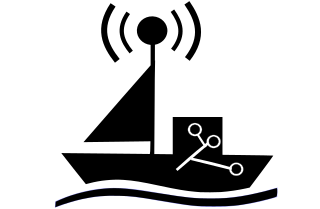
The Turkish Naval Forces, or Turkish Navy, is the naval warfare service branch of the Turkish Armed Forces.

Aselsan A.Ş. is a Turkish defense corporation headquartered in Ankara, Turkey. Its main operating area is research, development and manufacture of advanced military products for air, land and maritime forces. The company is one of the major contractors of the Turkish Armed Forces. Aselsan was ranked by Defense News as the 48th largest defense company in terms of revenue. The Turkish Army Foundation is the founder, and it's successor, the Turkish Armed Forces Foundation, is the major stockholder.

An unmanned surface vehicle, unmanned surface vessel or uncrewed surface vessel (USV), colloquially called a drone boat, drone ship or sea drone, is a boat or ship that operates on the surface of the water without a crew. USVs operate with various levels of autonomy, from remote control to fully autonomous surface vehicles (ASV).

The TAI Anka is a family of unmanned aerial vehicles developed by Turkish Aerospace Industries primarily for the Turkish Air Force. Envisioned in the early 2000s for aerial surveillance and reconnaissance missions, Anka has evolved into a modular platform with synthetic-aperture radar, precise weapons and satellite communication.

The defense industry of Turkey has a long history, dated from the Ottoman Empire, and has changed several times during the Republic period.

The ASW Continuous Trail Unmanned Vessel (ACTUV) is a DARPA funded project launched in early 2010 to develop an anti-submarine drone. ASW is an acronym for Anti-Submarine Warfare. In January 2018 after successful sea trials it was announced that the "Sea Hunter" prototype has transitioned from DARPA to the Office of Naval Research for further development.
Seaborne targets are vessels or floating structures that are shot at for practice by naval or air forces. They may be remotely controlled and mobile, or towed behind other craft, or just set adrift in the sea.
The Hammerhead USV-T is a remote-controlled, high-speed seaborne target drone used for naval training. The craft is built and produced by Meggitt Training Systems in cooperation with A. F. Theriault & Son Ltd and approximately 80 other companies that produce innards and accessories of the boats. The Hammerhead USV-T is used for tactical training scenarios at sea.

The Raytheon Coyote is a small, expendable, unmanned aircraft system built by the Raytheon Company, with the capability of operating in autonomous swarms. It is launched from a sonobuoy canister with the wings deploying in early flight phase.

WB Electronics Warmate is a class of loitering munition UAVs developed by the Polish defence contractor WB Group. It can be equipped with several different payloads, including fragmentation, HEAT and thermobaric warheads and has a swarming capability.

Bayraktar Akıncı is a high-altitude long-endurance (HALE) unmanned combat aerial vehicle (UCAV) being manufactured by the Turkish defence company Baykar. The first three units entered service with the Turkish Armed Forces on 29 August 2021.
The JARI USV is an uncrewed surface vehicle developed by the China Shipbuilding Industry Corporation (CSIC), specifically between its No. 716 Research Institute, the Jiangsu Automation Research Institute (JARI), and No. 702 Research Institute, China Ship Scientific Research Centre (CSRRC). The uncrewed warship is designed for potential use for the People's Liberation Army Navy and export customers.
The HAL Combat Air Teaming System (CATS) is an Indian unmanned and manned combat aircraft air teaming system being developed by Hindustan Aeronautics Limited (HAL). The system will consist of a manned fighter aircraft acting as "mothership" of the system and a set of swarming UAVs and UCAVs governed by the mothership aircraft. A twin-seated HAL Tejas is likely to be the mothership aircraft. Various other sub components of the system are currently under development and will be jointly produced by HAL, National Aerospace Laboratories (NAL), Defence Research and Development Organisation (DRDO) and Newspace Research & Technologies.

The Bayraktar Kızılelma is a single-engine, low-observable, carrier-capable, jet-powered unmanned combat aerial vehicle (UCAV), currently in development by Turkish defense company Baykar. The aircraft is being developed as part of Project MIUS. The initial Bayraktar Kızılelma (Kızılelma-A) is subsonic. Planned variants are intended to be supersonic, the latter having a twin-engined configuration. It is one of the two Turkish jet-powered stealth UCAV along with TAI Anka-3.

The Baykar Bayraktar TB3 is a Turkish medium-altitude long-endurance (MALE) unmanned combat aerial vehicle (UCAV) capable of short-range landing and take-off, produced by Baykar. According to the initial plans, the ship TCG Anadolu was expected to be equipped with Lockheed Martin F-35B Lightning II fighter jets but the vessel entered a modification process to allow it to be able to accommodate UAVs such as Bayraktar TB3 following the removal of Turkey from the F-35 procurement program.
SİPER is a long-range surface-to-air missile (SAM) air defense system that is currently under development in Turkey. Designed to defend against any type of airborne threat, it can fight aircraft, cruise missiles, air-to-ground missiles and unmanned aerial vehicles (UAVs). It was jointly developed in Turkey by the companies Roketsan, Aselsan and the research institute TÜBİTAK SAGE.
The Anka-3 is a flying wing type stealth UCAV currently in development by Turkish Aerospace Industries. It is one of two Turkish jet-powered stealth UCAVs developed as part of Project MIUS, along with the Bayraktar Kızılelma.
Albatros USV family consists of high-speed unmanned surface seaborne targets of catamaran-type Albatros-K, swarm-type Albatros-S and V-hull-type Albatros-T built by the Turkish defense company Aselsan for the needs of the Turkish Naval Forces.
Albatros-K is a Turkish catamaran-type high-speed unmanned surface vessel (USV) of the Turkish Navy developed by the Turkish defense company Aselsan.










